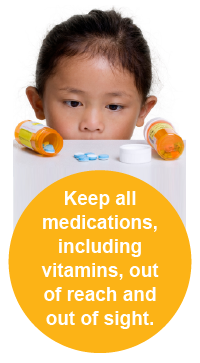I have never had to think about the consequences of an overdose until recently. A trip to the emergency room, medications given that I do not take on a regular basis, an allergic reaction and more. This situation has led to me rethinking when and how overdoses happen and if naloxone should be on hand for everyone. I have decided that I need to get more information and I need to be more educated. That line of thinking has led me to learn more and be better. I was not aware that you can overdose on depressants, alcohol, opioids, prescription medications and so much more. I did not think that just going to an emergency room would create a need for education. I did not think that something as simple as combining medications could have such disastrous outcomes. I encourage others to learn about overdose and naloxone. https://www.addictioncenter.com/drugs/overdose/
Author: Brenda Plascencia
Cooking Safety Parent Checklist
Safe Kids provides a cooking safety list with everything you need to know to keep your kids safe while cooking. Follow the link below for the checklist.
https://www.safekids.org/tip/cooking-safety-parent-checklist
Choosing the Right Car Seat
Selecting the right car seat for your child can raise a lot of questions. What do we buy? Which car seat is safest? When do we change car seats? Safe Kids offers some helpful information to answer these questions.
The best car seat is the one that fits your child, the one that fits your vehicle, and the one that you can use correctly each and every time. All car seats approved for sale in the U.S. have met the same safety standards, so rest assured that a $50 car seat has passed the same tests as a $300 car seat. However, in recent years, there have been knock-off car seats sold online, so you will want to be cautious when purchasing from a third-party vendor. You can find a helpful tip sheet on this topic here.
Generally, each child should be riding in four seat types as they grow: rear-facing, forward-facing, booster seat, seat belt. Do not rush when moving from one seat to another. Every step forward reduces safety just a bit.
- Rear-facing Car Seats: Every child will begin riding rear-facing. A child is much safer riding rear-facing than forward-facing, and it is recommended that your child remains rear-facing until they reach the upper rear-facing height or weight limit for their car seat. That doesn’t mean your child is ready to ride forward-facing once they outgrow their rear-facing only car seat. A convertible car seat can be used both rear-facing and forward-facing, and will have higher height and weight limits than a rear-facing only car seat.
- Forward-facing Car Seats: When your child has outgrown the upper rear-facing weight or height limits of their car seat, they will ride forward-facing. A child should ride in a forward-facing car seat with a 5-point harness and top tether until they reach the upper forward-facing height or weight limit of their car seat.
- Booster seats: Once your child outgrows the upper weight or height limits of the forward-facing, five-point harness car seat, use a belt-positioning booster seat with the vehicle lap and shoulder seat belt. The shoulder strap should fit across the chest and on the shoulder, not across the face or neck, and the lap belt should be low across their hips or upper thighs, and not across their stomach.
- Seat belts: In order to use the seat belt alone, your child should be able to pass the seat belt fit test. This means that 1) the shoulder belt sits across their chest and shoulders, not touching their neck 2) their lower back is against the vehicle seat 3) the lap belt is low across their hips or upper thighs, not across their stomach 4) their knees can bend at the edge of the seat and 5) they can sit like this for the entire ride. Sometimes, children will meet this five-step fit test in some cars, but not others.
We recommend that you avoid purchasing a car seat from a yard sale or second-hand store as you cannot ensure its history. It is important to know if a car seat is expired, if it has been in a wreck, and if it has all of its parts. We also recommend that all children under the age of 13 ride in the back seat.
These are just a few recommendations for selecting the appropriate seat for your child. There is a lot to know about proper car seat use and you will want to read the manual that comes with your child’s car seat or booster seat. We also recommend that you attend a car seat check-up where a certified Child Passenger Safety Technician can teach you how to install and use your seat correctly. In order for your car seat to protect your child they way it is designed to, it must be installed and used correctly every time. To learn more about choosing a car seat, installing a car seat, and more, please visit ultimatecarseatguide.org.

